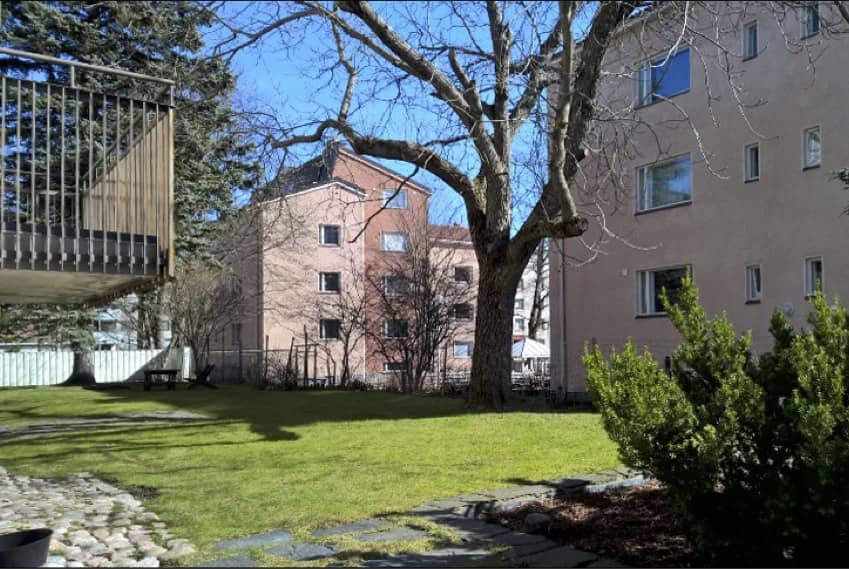
www.buildingsandcities.org/insights/commentaries/housing-lessons-for-post-covid19.html
Housing: Lessons for a Post-COVID-19 World

How can housing be healthy, adaptable, resilient and optimised for the multiple functions?
Dwellings provide not just a living space, but act as a pandemic shelter, a workplace, an impromptu school, a gym, a playground and more. Katja Maununaho, Sini Saarimaa, Jyrki Tarpio and Sofie Pelsmakers (Tampere University) critique current apartment design and contemplate how apartments can be designed to be adaptable and respond better to many existing and new needs.
Exceptional times provide an opportunity to reflect on the different realities of living. Restrictions on movement set as protective measures provide a tangible demonstration of how the built environment can feel for those whose movement has been permanently restricted. This highlights both the challenges and the opportunities associated with transforming homes into multiple use spaces: used by multiple people for multiple purposes, potentially with issues of safety, privacy, noise with health and well-being implications.
What characteristics of a dwelling's plan make the quarantine conditions feel tolerable? Enough room so all family members don't have to be face to face all the time? A little empty space between the furniture? A chance to walk back and forth? A sink situated around a corner, so you don't have to look at the mess from the evening before? A window with a view of urban trees or a garden?
Daylight and window configuration
In deep-plan apartment buildings, many spaces are left with little natural light. This limitation has been shown to have an impact on the perceived dimensions of the spatial configuration (Saarimaa, 2020). The amount of natural light and views out affect the sense of space (Stamps, 2010). Therefore, the number and positioning of window openings are critical. With the trend of decreased apartment size, daylighting design is a means to create apartments that are perceived as more spacious than what they actually are. However, this cannot be a replacement for the amount and variety of space to accommodate multiple uses.
Daylight design can also influence how easily an apartment can be modified to meet the different residents' needs (Saarimaa & Pelsmakers, 2020). If a kitchen is positioned deep within the building as a part of the main open plan living area but without a window, then it limits the potential to convert the space to accommodate different needs. Similarly, a roughly 15 m2 living space cannot be divided into two smaller rooms should the need arise, unless the fenestration also supports this.
Deep-plan one-room apartments with only a single window are difficult, if not impossible, to combine together later into a larger unit in the case that the single dwellers value more communal living in the future. Window placement and daylighting design therefore have a significant effect on the adaptability of an apartment and a residential building over time (Saarimaa & Pelsmakers, 2020). It is important to ensure that the apartment stock constructed today can withstand social change and is future proofed for the next generations of dwellers.
These design considerations matter as they determine the adaptability potential and quality of our homes. The current pandemic and the 'temporary' conditions reveal a need to accommodate changing conditions, i.e. spending more time in our living spaces, working at home, and schooling kids at home.
Adaptable layout
Unfortunately, many apartments, especially in new buildings can often be furnished and used in only a one single way. A trend in new homes is open plan 'walk-through' spaces, which makes it difficult to find several quiet places, for example, to work from home.
New buildings are more optimized than older apartment buildings: the goal has been to place as many apartments as possible in one stairwell and also to tune the building depth to the maximum allowed (Saarimaa & Pelsmakers, 2020; Tarpio, 2020). It mainly focuses on optimizing plot efficiency and building input efficiency instead of housing usability and adaptability. Particularly the smallest of studio apartments only work with the support of public and commercial spaces (e.g. small kitchens and living spaces). The assumption is residents will spend little time at home, social entertaining will happen outside the home as their dwelling is too small to accommodate this.
Urban resilience
Our homes serve a variety of functions. At short notice, dwellings provide not just a living space, but pandemic shelter, a workplace, an impromptu school, a gym, a playground, for one person or many people. Lockdown measures have also highlighted the need to embed our homes in an urban landscape that is naturally resilient.
An example of the importance of a resilient urban milieu is the exceptional heat wave of 1995 in Chicago. The American sociologist Eric Klinenberg (1999) analysed the mortality rates caused by heat in various residential areas. A higher level of deprivation and a higher proportion of older people were associated with increased mortality. Yet, some low-income neighbourhoods stood out in the statistics as more resilient than others. Klinenberg found that features of the built environment, such as a lively pedestrian environment, well-maintained parks, and local commercial services, distinguished the neighbourhoods and made them more vibrant (see also Gehl, 2010). Klinenberg concluded that the social infrastructure created by the physical environment can support residents by increasing social capital. The sociality of everyday relationships and interpersonal networks in the neighbourhood can help to ultimately reduce mortality. Klinenberg's research shows that the characteristics of the built environment are of considerable importance to human health and well-being.
These observations give new weight to demands for the quality of the living environment to be healthy, adaptable and resilient. The coming decades will bring us situations that affect everyday life that we cannot yet imagine, including a changing climate. At the same time, new pandemics might force similar, or even more severe restrictions to our everyday lives.
Anticipating a changing climate
The biological, social, health and economic impacts of climate change will further test the operational potential of the living environment. Housing is more than a refuge for togetherness, rest, dining and hygiene. Housing supports people's basic needs, which include physical and mental well-being, and inclusion as a member of communities and society (Luoma-Halkola et al., 2019). As recent weeks have shown, the fulfilment of these basic needs cannot always be outsourced from an apartment to a public urban space. The lockdown has shown that private spaces can become proxy 'public' spaces: people forced to work from home and children learning at home. People's homes function as semi-public spaces (Tagliaro, 2020). This experience suggests that flexibility and adaptability of spatial design offers new potentials to address urgent and future challenges.
Rethinking regulation and standards
Housing production is a business aimed at economic return. Apartments can be designed to be adaptable and with flexible plans; at present their generally inflexible shortcomings are by-products of the profitability problem: the need to maximise the number of dwellings overrides quality issues (Saarimaa & Pelsmakers, 2020). Nevertheless, the economy is always about political choices as well, and the current crisis might be the catalyst for reassessing mandated housing standards (Eisenberg & Diamond, 2020).We should aim to define new goals and standards to design and build housing that is both resilient and adaptable to climate change and that meets high sustainability standards, but also provides the flexibility and adaptability of use, for day-day adaptability needs as residents' needs change, but now also as needed in a local or global emergency.
The crisis of recent weeks has shown the readiness of our political system to make socially and economically difficult decisions. With regard to housing design, the necessity of the situation and the links between actions and objectives have not yet been addressed in decision-making. A comprehensive rethink of space standards and the regulations for housing design is necessary, and pressing, given the next (and much bigger) emergency of climate change.
References
Eisenberg, D & Diamond, R. (2020). After COVID-19: opportunity for changing building regulations?Buildings & Cities [commentary] https://www.buildingsandcities.org/insights/commentaries/after-covid-19-regulation.html
Gehl, Jan/ (2010). Cities for People. Washington: Island Press.
Klinenberg, Eric. (1999). "Denaturalizing disaster: a social autopsy of the 1995 Chicago heat wave. Theory and Society, vol. 28, no. 2, 1999, pp. 239-295. JSTOR, www.jstor.org/stable/3108472.
Luoma-Halkola, H., Häikiö, L., Maununaho, K., & Sointu, L. (2019). Asumisen tarpeet - peruslähtökohta [Housing needs - basics]. Ketterän asumisen keittokirja. https://housingcookbook.com/aiheet/asumisen-tarpeet-%E2%80%93-peruslahtokohta
Saarimaa, S. (2020). Natural light affects the perceived spaciousness and adaptability of an apartment. Finnish Architectural Review, 2/2020.
Saarimaa, S & Pelsmakers, S. (2020, in press). Better living environment today, more adaptable tomorrow? Comparative analysis of Finnish apartment buildings and their adaptable scenarios. The Finnish Journal of Urban Studies. July 2020.
Stamps, A. E. (2010). Effects of permeability on perceived enclosure and spaciousness. Environment and Behavior, 42(6):864-886. https://doi.org/10.1177/0013916509337287
Tagliaro, C. (2020). Will working from home become the new normal? Buildings & Cities [commentary] https://www.buildingsandcities.org/insights/commentaries/working-from-home.html
Tarpio, Jyrki. (2020). Kestäviä kaksioita kestävissä kerrostaloissa? [Sustainable flats in sustainable buildings?] Arkkitehtiuutiset 2020 / 5, pp. 10-13. http://www.e-julkaisu.fi/SAFA/au_arkkitehtiuutiset/5-2020/mobile.html#pid=10
Latest Peer-Reviewed Journal Content
Acceptability of sufficiency consumption policies by Finnish households
E Nuorivaara & S Ahvenharju
Key factors for revitalising heritage buildings through adaptive reuse
É Savoie, J P Sapinski & A-M Laroche
Cooler streets for a cycleable city: assessing policy alignment
C Tang & J Bush
Understanding the embodied carbon credentials of modern methods of construction
R O'Hegarty, A McCarthy, J O'Hagan, T Thanapornpakornsin, S Raffoul & O Kinnane
The changing typology of urban apartment buildings in Aurinkolahti
S Meriläinen & A Tervo
Embodied climate impacts in urban development: a neighbourhood case study
S Sjökvist, N Francart, M Balouktsi & H Birgisdottir
Environmental effects of urban wind energy harvesting: a review
I Tsionas, M laguno-Munitxa & A Stephan
Office environment and employee differences by company health management certification
S Arata, M Sugiuchi, T Ikaga, Y Shiraishi, T Hayashi, S Ando & S Kawakubo
Spatiotemporal evaluation of embodied carbon in urban residential development
I Talvitie, A Amiri & S Junnila
Energy sufficiency in buildings and cities: current research, future directions [editorial]
M Sahakian, T Fawcett & S Darby
Sufficiency, consumption patterns and limits: a survey of French households
J Bouillet & C Grandclément
Health inequalities and indoor environments: research challenges and priorities [editorial]
M Ucci & A Mavrogianni
Operationalising energy sufficiency for low-carbon built environments in urbanising India
A B Lall & G Sethi
Promoting practices of sufficiency: reprogramming resource-intensive material arrangements
T H Christensen, L K Aagaard, A K Juvik, C Samson & K Gram-Hanssen
Culture change in the UK construction industry: an anthropological perspective
I Tellam
Are people willing to share living space? Household preferences in Finland
E Ruokamo, E Kylkilahti, M Lettenmeier & A Toppinen
Towards urban LCA: examining densification alternatives for a residential neighbourhood
M Moisio, E Salmio, T Kaasalainen, S Huuhka, A Räsänen, J Lahdensivu, M Leppänen & P Kuula
A population-level framework to estimate unequal exposure to indoor heat and air pollution
R Cole, C H Simpson, L Ferguson, P Symonds, J Taylor, C Heaviside, P Murage, H L Macintyre, S Hajat, A Mavrogianni & M Davies
Finnish glazed balconies: residents' experience, wellbeing and use
L Jegard, R Castaño-Rosa, S Kilpeläinen & S Pelsmakers
Modelling Nigerian residential dwellings: bottom-up approach and scenario analysis
C C Nwagwu, S Akin & E G Hertwich
Mapping municipal land policies: applications of flexible zoning for densification
V Götze, J-D Gerber & M Jehling
Energy sufficiency and recognition justice: a study of household consumption
A Guilbert
Linking housing, socio-demographic, environmental and mental health data at scale
P Symonds, C H Simpson, G Petrou, L Ferguson, A Mavrogianni & M Davies
Measuring health inequities due to housing characteristics
K Govertsen & M Kane
Provide or prevent? Exploring sufficiency imaginaries within Danish systems of provision
L K Aagaard & T H Christensen
Imagining sufficiency through collective changes as satisfiers
O Moynat & M Sahakian
US urban land-use reform: a strategy for energy sufficiency
Z M Subin, J Lombardi, R Muralidharan, J Korn, J Malik, T Pullen, M Wei & T Hong
Mapping supply chains for energy retrofit
F Wade & Y Han
Operationalising building-related energy sufficiency measures in SMEs
I Fouiteh, J D Cabrera Santelices, A Susini & M K Patel
Promoting neighbourhood sharing: infrastructures of convenience and community
A Huber, H Heinrichs & M Jaeger-Erben
New insights into thermal comfort sufficiency in dwellings
G van Moeseke, D de Grave, A Anciaux, J Sobczak & G Wallenborn
'Rightsize': a housing design game for spatial and energy sufficiency
P Graham, P Nourian, E Warwick & M Gath-Morad
Implementing housing policies for a sufficient lifestyle
M Bagheri, L Roth, L Siebke, C Rohde & H-J Linke
The jobs of climate adaptation
T Denham, L Rickards & O Ajulo
Structural barriers to sufficiency: the contribution of research on elites
M Koch, K Emilsson, J Lee & H Johansson
Disrupting the imaginaries of urban action to deliver just adaptation [editorial]
V Castán-Broto, M Olazabal & G Ziervogel
Nature for resilience reconfigured: global- to-local translation of frames in Africa
K Rochell, H Bulkeley & H Runhaar
How hegemonic discourses of sustainability influence urban climate action
V Castán Broto, L Westman & P Huang
Fabric first: is it still the right approach?
N Eyre, T Fawcett, M Topouzi, G Killip, T Oreszczyn, K Jenkinson & J Rosenow
Social value of the built environment [editorial]
F Samuel & K Watson
Understanding demolition [editorial]
S Huuhka
Data politics in the built environment [editorial]
A Karvonen & T Hargreaves



Latest Commentaries
Decolonising Cities: The Role of Street Naming
During colonialisation, street names were drawn from historical and societal contexts of the colonisers. Street nomenclature deployed by colonial administrators has a role in legitimising historical narratives and decentring local languages, cultures and heritage. Buyana Kareem examines street renaming as an important element of decolonisation.
Integrating Nature into Cities
Increasing vegetation and green and blue spaces in cities can support both climate change mitigation and adaptation goals, while also enhancing biodiversity and ecological health. Maibritt Pedersen Zari (Auckland University of Technology) explains why nature-based solutions (NbS) must be a vital part of urban planning and design.